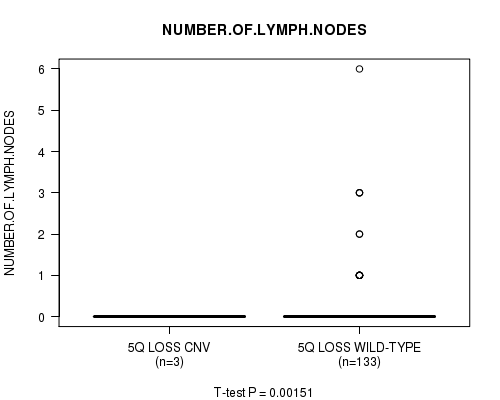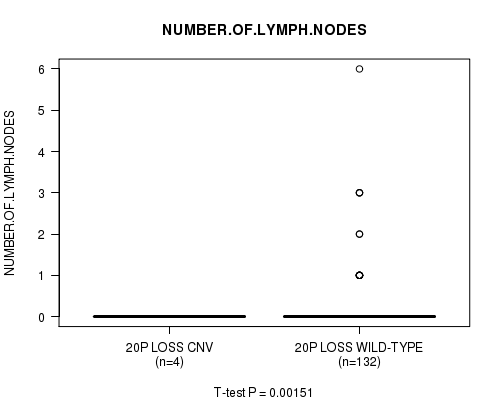This pipeline computes the correlation between significant arm-level copy number variations (cnvs) and selected clinical features.
Testing the association between copy number variation 25 arm-level results and 6 clinical features across 155 patients, 5 significant findings detected with Q value < 0.25.
-
1q gain cnv correlated to 'NUMBER.OF.LYMPH.NODES'.
-
3p gain cnv correlated to 'NUMBER.OF.LYMPH.NODES'.
-
5q loss cnv correlated to 'NUMBER.OF.LYMPH.NODES'.
-
13q loss cnv correlated to 'LYMPH.NODE.METASTASIS'.
-
20p loss cnv correlated to 'NUMBER.OF.LYMPH.NODES'.
Table 1. Get Full Table Overview of the association between significant copy number variation of 25 arm-level results and 6 clinical features. Shown in the table are P values (Q values). Thresholded by Q value < 0.25, 5 significant findings detected.
|
Clinical Features |
Time to Death |
AGE |
LYMPH NODE METASTASIS |
COMPLETENESS OF RESECTION |
NUMBER OF LYMPH NODES |
TUMOR STAGECODE |
||
| nCNV (%) | nWild-Type | logrank test | t-test | Fisher's exact test | Fisher's exact test | t-test | t-test | |
| 1q gain | 0 (0%) | 151 |
1 (1.00) |
0.297 (1.00) |
1 (1.00) |
0.228 (1.00) |
0.00151 (0.186) |
|
| 3p gain | 0 (0%) | 151 |
1 (1.00) |
0.644 (1.00) |
1 (1.00) |
0.604 (1.00) |
0.00151 (0.186) |
|
| 5q loss | 0 (0%) | 152 |
1 (1.00) |
0.213 (1.00) |
1 (1.00) |
1 (1.00) |
0.00151 (0.186) |
|
| 13q loss | 0 (0%) | 144 |
1 (1.00) |
0.809 (1.00) |
0.000216 (0.0268) |
1 (1.00) |
0.1 (1.00) |
|
| 20p loss | 0 (0%) | 151 |
1 (1.00) |
0.447 (1.00) |
1 (1.00) |
0.228 (1.00) |
0.00151 (0.186) |
|
| 3q gain | 0 (0%) | 150 |
1 (1.00) |
0.358 (1.00) |
0.448 (1.00) |
1 (1.00) |
0.438 (1.00) |
|
| 7p gain | 0 (0%) | 141 |
1 (1.00) |
0.0184 (1.00) |
0.0284 (1.00) |
0.774 (1.00) |
0.169 (1.00) |
|
| 7q gain | 0 (0%) | 143 |
1 (1.00) |
0.0672 (1.00) |
0.304 (1.00) |
1 (1.00) |
0.967 (1.00) |
|
| 8p gain | 0 (0%) | 148 |
1 (1.00) |
0.628 (1.00) |
0.172 (1.00) |
0.405 (1.00) |
0.679 (1.00) |
|
| 8q gain | 0 (0%) | 141 |
1 (1.00) |
0.68 (1.00) |
0.157 (1.00) |
0.427 (1.00) |
0.846 (1.00) |
|
| 9p gain | 0 (0%) | 152 |
1 (1.00) |
0.72 (1.00) |
0.298 (1.00) |
0.553 (1.00) |
||
| 9q gain | 0 (0%) | 151 |
1 (1.00) |
0.694 (1.00) |
0.298 (1.00) |
1 (1.00) |
0.553 (1.00) |
|
| 10q gain | 0 (0%) | 152 |
1 (1.00) |
0.145 (1.00) |
0.298 (1.00) |
1 (1.00) |
0.456 (1.00) |
|
| 6q loss | 0 (0%) | 148 |
1 (1.00) |
0.257 (1.00) |
0.567 (1.00) |
1 (1.00) |
0.607 (1.00) |
|
| 8p loss | 0 (0%) | 116 |
1 (1.00) |
0.0835 (1.00) |
0.213 (1.00) |
0.495 (1.00) |
0.0925 (1.00) |
|
| 8q loss | 0 (0%) | 151 |
1 (1.00) |
0.644 (1.00) |
0.0601 (1.00) |
1 (1.00) |
0.247 (1.00) |
|
| 10p loss | 0 (0%) | 151 |
1 (1.00) |
0.679 (1.00) |
0.377 (1.00) |
1 (1.00) |
0.87 (1.00) |
|
| 10q loss | 0 (0%) | 151 |
1 (1.00) |
0.398 (1.00) |
0.0601 (1.00) |
0.604 (1.00) |
0.327 (1.00) |
|
| 12p loss | 0 (0%) | 148 |
1 (1.00) |
0.677 (1.00) |
0.00285 (0.339) |
0.405 (1.00) |
0.142 (1.00) |
|
| 16q loss | 0 (0%) | 135 |
1 (1.00) |
0.277 (1.00) |
0.0376 (1.00) |
0.638 (1.00) |
0.206 (1.00) |
|
| 17p loss | 0 (0%) | 136 |
1 (1.00) |
0.451 (1.00) |
0.0297 (1.00) |
0.517 (1.00) |
0.128 (1.00) |
|
| 18p loss | 0 (0%) | 141 |
1 (1.00) |
0.876 (1.00) |
0.637 (1.00) |
0.544 (1.00) |
0.483 (1.00) |
|
| 18q loss | 0 (0%) | 135 |
1 (1.00) |
0.702 (1.00) |
0.114 (1.00) |
0.517 (1.00) |
0.239 (1.00) |
|
| 21q loss | 0 (0%) | 152 |
1 (1.00) |
0.395 (1.00) |
0.298 (1.00) |
1 (1.00) |
0.502 (1.00) |
|
| 22q loss | 0 (0%) | 151 |
1 (1.00) |
0.462 (1.00) |
0.377 (1.00) |
0.228 (1.00) |
0.51 (1.00) |
P value = 0.00151 (t-test), Q value = 0.19
Table S1. Gene #1: '1q gain' versus Clinical Feature #5: 'NUMBER.OF.LYMPH.NODES'
| nPatients | Mean (Std.Dev) | |
|---|---|---|
| ALL | 136 | 0.2 (0.7) |
| 1Q GAIN CNV | 4 | 0.0 (0.0) |
| 1Q GAIN WILD-TYPE | 132 | 0.2 (0.8) |
Figure S1. Get High-res Image Gene #1: '1q gain' versus Clinical Feature #5: 'NUMBER.OF.LYMPH.NODES'

P value = 0.00151 (t-test), Q value = 0.19
Table S2. Gene #2: '3p gain' versus Clinical Feature #5: 'NUMBER.OF.LYMPH.NODES'
| nPatients | Mean (Std.Dev) | |
|---|---|---|
| ALL | 136 | 0.2 (0.7) |
| 3P GAIN CNV | 4 | 0.0 (0.0) |
| 3P GAIN WILD-TYPE | 132 | 0.2 (0.8) |
Figure S2. Get High-res Image Gene #2: '3p gain' versus Clinical Feature #5: 'NUMBER.OF.LYMPH.NODES'

P value = 0.00151 (t-test), Q value = 0.19
Table S3. Gene #11: '5q loss' versus Clinical Feature #5: 'NUMBER.OF.LYMPH.NODES'
| nPatients | Mean (Std.Dev) | |
|---|---|---|
| ALL | 136 | 0.2 (0.7) |
| 5Q LOSS CNV | 3 | 0.0 (0.0) |
| 5Q LOSS WILD-TYPE | 133 | 0.2 (0.7) |
Figure S3. Get High-res Image Gene #11: '5q loss' versus Clinical Feature #5: 'NUMBER.OF.LYMPH.NODES'

P value = 0.000216 (Fisher's exact test), Q value = 0.027
Table S4. Gene #18: '13q loss' versus Clinical Feature #3: 'LYMPH.NODE.METASTASIS'
| nPatients | N0 | N1 |
|---|---|---|
| ALL | 121 | 15 |
| 13Q LOSS CNV | 5 | 6 |
| 13Q LOSS WILD-TYPE | 116 | 9 |
Figure S4. Get High-res Image Gene #18: '13q loss' versus Clinical Feature #3: 'LYMPH.NODE.METASTASIS'

P value = 0.00151 (t-test), Q value = 0.19
Table S5. Gene #23: '20p loss' versus Clinical Feature #5: 'NUMBER.OF.LYMPH.NODES'
| nPatients | Mean (Std.Dev) | |
|---|---|---|
| ALL | 136 | 0.2 (0.7) |
| 20P LOSS CNV | 4 | 0.0 (0.0) |
| 20P LOSS WILD-TYPE | 132 | 0.2 (0.8) |
Figure S5. Get High-res Image Gene #23: '20p loss' versus Clinical Feature #5: 'NUMBER.OF.LYMPH.NODES'

-
Mutation data file = broad_values_by_arm.mutsig.cluster.txt
-
Clinical data file = PRAD-TP.clin.merged.picked.txt
-
Number of patients = 155
-
Number of significantly arm-level cnvs = 25
-
Number of selected clinical features = 6
-
Exclude genes that fewer than K tumors have mutations, K = 3
For survival clinical features, the Kaplan-Meier survival curves of tumors with and without gene mutations were plotted and the statistical significance P values were estimated by logrank test (Bland and Altman 2004) using the 'survdiff' function in R
For continuous numerical clinical features, two-tailed Student's t test with unequal variance (Lehmann and Romano 2005) was applied to compare the clinical values between tumors with and without gene mutations using 't.test' function in R
For binary or multi-class clinical features (nominal or ordinal), two-tailed Fisher's exact tests (Fisher 1922) were used to estimate the P values using the 'fisher.test' function in R
For multiple hypothesis correction, Q value is the False Discovery Rate (FDR) analogue of the P value (Benjamini and Hochberg 1995), defined as the minimum FDR at which the test may be called significant. We used the 'Benjamini and Hochberg' method of 'p.adjust' function in R to convert P values into Q values.
This is an experimental feature. The full results of the analysis summarized in this report can be downloaded from the TCGA Data Coordination Center.